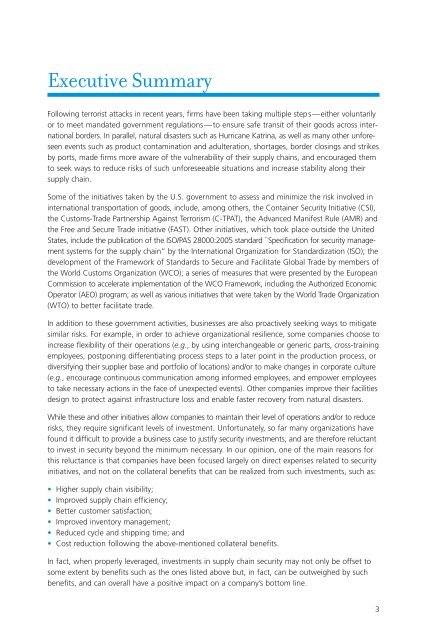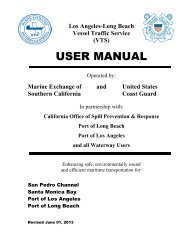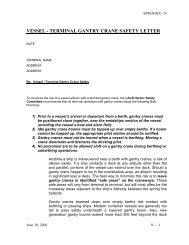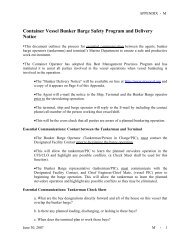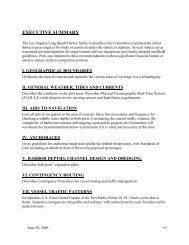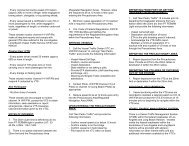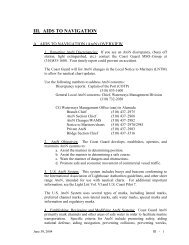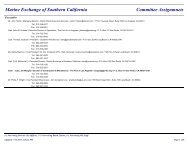Innovators in Supply Chain Security: - IBM
Innovators in Supply Chain Security: - IBM
Innovators in Supply Chain Security: - IBM
You also want an ePaper? Increase the reach of your titles
YUMPU automatically turns print PDFs into web optimized ePapers that Google loves.
Executive Summary<br />
Follow<strong>in</strong>g terrorist attacks <strong>in</strong> recent years, firms have been tak<strong>in</strong>g multiple steps—either voluntarily<br />
or to meet mandated government regulations—to ensure safe transit of their goods across <strong>in</strong>ternational<br />
borders. In parallel, natural disasters such as Hurricane Katr<strong>in</strong>a, as well as many other unforeseen<br />
events such as product contam<strong>in</strong>ation and adulteration, shortages, border clos<strong>in</strong>gs and strikes<br />
by ports, made firms more aware of the vulnerability of their supply cha<strong>in</strong>s, and encouraged them<br />
to seek ways to reduce risks of such unforeseeable situations and <strong>in</strong>crease stability along their<br />
supply cha<strong>in</strong>.<br />
Some of the <strong>in</strong>itiatives taken by the U.S. government to assess and m<strong>in</strong>imize the risk <strong>in</strong>volved <strong>in</strong><br />
<strong>in</strong>ternational transportation of goods, <strong>in</strong>clude, among others, the Conta<strong>in</strong>er <strong>Security</strong> Initiative (CSI),<br />
the Customs-Trade Partnership Aga<strong>in</strong>st Terrorism (C-TPAT), the Advanced Manifest Rule (AMR) and<br />
the Free and Secure Trade <strong>in</strong>itiative (FAST). Other <strong>in</strong>itiatives, which took place outside the United<br />
States, <strong>in</strong>clude the publication of the ISO/PAS 28000:2005 standard ``Specification for security management<br />
systems for the supply cha<strong>in</strong>” by the International Organization for Standardization (ISO); the<br />
development of the Framework of Standards to Secure and Facilitate Global Trade by members of<br />
the World Customs Organization (WCO); a series of measures that were presented by the European<br />
Commission to accelerate implementation of the WCO Framework, <strong>in</strong>clud<strong>in</strong>g the Authorized Economic<br />
Operator (AEO) program; as well as various <strong>in</strong>itiatives that were taken by the World Trade Organization<br />
(WTO) to better facilitate trade.<br />
In addition to these government activities, bus<strong>in</strong>esses are also proactively seek<strong>in</strong>g ways to mitigate<br />
similar risks. For example, <strong>in</strong> order to achieve organizational resilience, some companies choose to<br />
<strong>in</strong>crease flexibility of their operations (e.g., by us<strong>in</strong>g <strong>in</strong>terchangeable or generic parts, cross-tra<strong>in</strong><strong>in</strong>g<br />
employees, postpon<strong>in</strong>g differentiat<strong>in</strong>g process steps to a later po<strong>in</strong>t <strong>in</strong> the production process, or<br />
diversify<strong>in</strong>g their supplier base and portfolio of locations) and/or to make changes <strong>in</strong> corporate culture<br />
(e.g., encourage cont<strong>in</strong>uous communication among <strong>in</strong>formed employees, and empower employees<br />
to take necessary actions <strong>in</strong> the face of unexpected events). Other companies improve their facilities<br />
design to protect aga<strong>in</strong>st <strong>in</strong>frastructure loss and enable faster recovery from natural disasters.<br />
While these and other <strong>in</strong>itiatives allow companies to ma<strong>in</strong>ta<strong>in</strong> their level of operations and/or to reduce<br />
risks, they require significant levels of <strong>in</strong>vestment. Unfortunately, so far many organizations have<br />
found it difficult to provide a bus<strong>in</strong>ess case to justify security <strong>in</strong>vestments, and are therefore reluctant<br />
to <strong>in</strong>vest <strong>in</strong> security beyond the m<strong>in</strong>imum necessary. In our op<strong>in</strong>ion, one of the ma<strong>in</strong> reasons for<br />
this reluctance is that companies have been focused largely on direct expenses related to security<br />
<strong>in</strong>itiatives, and not on the collateral benefits that can be realized from such <strong>in</strong>vestments, such as:<br />
• Higher supply cha<strong>in</strong> visibility;<br />
• Improved supply cha<strong>in</strong> efficiency;<br />
• Better customer satisfaction;<br />
• Improved <strong>in</strong>ventory management;<br />
• Reduced cycle and shipp<strong>in</strong>g time; and<br />
• Cost reduction follow<strong>in</strong>g the above-mentioned collateral benefits.<br />
In fact, when properly leveraged, <strong>in</strong>vestments <strong>in</strong> supply cha<strong>in</strong> security may not only be offset to<br />
some extent by benefits such as the ones listed above but, <strong>in</strong> fact, can be outweighed by such<br />
benefits, and can overall have a positive impact on a company’s bottom l<strong>in</strong>e.<br />
3


